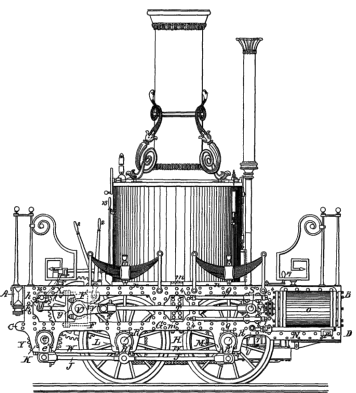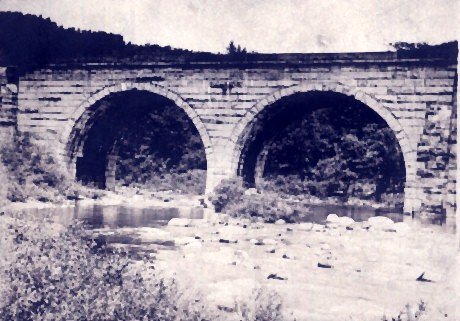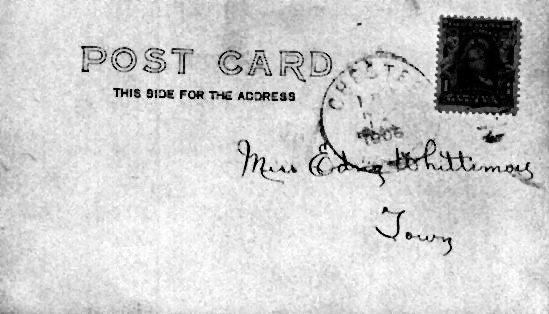|
|
Whistler's Wonders of the Westfield Branch While the West Branch of the Westfield River is the only one without a dam, that is not to say there are no grand earth and stone structures. Indeed, in terms of structure, the West Branch "rules." Along its length sit the first cluster of keystone arch railroad bridges built in America. They are wholly dry laid, range in height to 70 feet and made possible the longest and highest railroad in the world, the Western Railroad, in 1840. The passage was ingeniously surveyed by Major George Washington Whistler; James McNeil Whistler's father. So steep and remote it was said to be impossible, as ridiculous as a "railroad to the moon." Yet not to try meant Boston would lose ever more traffic to New York as they had since the Erie Canal opened in 1823. The canal siphoned traffic down the Hudson River, but a railroad to Albany could recapture that trade. Following the West Branch gave the railroad builders the lowest altitude crossing of the Berkshire Range (1458 ft.) The serpentine course of the river made constant bridging necessary. Stonemason Alexander Birnie of Stockbridge was brought in to construct 27 bridges, culverts and walls in the mountain section of the line. Most impressive of these edifices were ten keystone arch bridges over the winding Westfield. The beauty of these structures has drawn visitors for decades, all trespassers on the property of various successor companies to the Western (now CSX). This dangerous practice was the only access until the recent completion of a hiking trail to two bridges abandoned in a 1912 line relocation. The trail and empty bridges are wholly on the property of the state Division of Fisheries and Wildlife. While people have worked hard and are willing to hike a long way to experience these monuments, there is another way to see them, including those still carrying trains high above the river; in a kayak or a C-1. Cautions must be given that this is a re-mote area which, in fact, boasts the largest road-less tract in western Massachusetts. Rapids are a "good III to III plus" according to Jeff DeFeo, Whitewater Race organizer. He also says the river is uncontrolled and can rise suddenly or be too low to get through. A trip down stream from the Bancroft section of Middlefield along Town Hill Rd., takes you along a wondrous Wild & Scenic stream with massive reminders of the Early Industrial Age. The thought may suggest desecration of wilderness but, on the contrary, these bridges, of local stone, have the ability to meld with, even enhance their surroundings, as well as change appearance with the seasons. The Third Edition of the Appalachian Mountain Club "Classic Northeastern Whitewater Guide" describes an invigorating six mile trip with a 50 foot/mile and up to 100 foot/mile drop. While "rail-road bridges" are mentioned, it in no way prepares the rider for the awesome monuments they will encounter. They do allow that the scenery is "Excellent" and rate difficulty at III-IV. Some new bridges were constructed with the line relocation, also of the arch design, only built with concrete rather than stone. This trip starts at a stone bridge, still carrying trains, then the twisting path leads successively under a concrete arch with trains, then two magnificent granite arches 70 and 65 feet overhead. These bridges were bypassed and now carry only hikers on the Keystone Arch Bridge Trail. Next is a concrete arch right beside a stone bridge, giving a tunnel effect. This is where the old and new lines diverge. Last is the only double arch bridge in the series. It is also in use by the railroad. The story of the Keystone Arch Bridge Trail concerns local citizens who took action when progress with a $569,000 Interstate Surface Transportation Enhancement Act (ISTEA) grant disbursement came to a halt (where it remains). The Pioneer Valley Planning Commission had carried the trail planning to a point where there was a hard design for the pathway that could be implemented by volunteers. Ground was broken by an AmeriCorps crew in the summer of 2000. When school began that September, Dave Pierce of the Maintenance Dept. and Joseph Charnley, a teacher, both at Gateway Regional School District, hatched a plan to utilize Charnley's Outdoor Activities Program (OAP) to continue the trail work during school vacations. While the winter of 2000"2001 was a rough one, OAP was able to carry out all of the "above ground" work on the trail. This included the effort to cut and remove fallen trees, prune any branches in the treadway and the removal of trees in the trail. AmeriCorps returned in July of '01, essentially completing the scratch-built portion of the trail. Other sections employ the abandoned roadbed and a portion of the ancient stagecoach road to Albany, the Pontoosic Turnpike. Much remains to be done, however. There remains an abundance of brush, trees and rocks to be removed from other sections of the walkway. Presently, students in the Art and Metal departments at Gateway Regional High School are working on informational signs to be placed along the trail; this, with the help of a generous grant from the Hill town Coalition for Youth and Community Needs. The Friends of the Keystone Arches was formed to coordinate efforts in this direction. They offer a trail map free of charge, but donations for the work are accepted and appreciated. The map may be obtained by sending a large (#10 size) SASE to: Friends of the Keystone Arches P.0. Box 276 Huntington, MA 01050
|
||
|
Fascinating History! Everyone is overwhelmed by the beauty of the Arches when seeing them for the first time. But this amazement ultimately launches a hunger for the story of their creation. What burning desire would cause men to place these evocative structures in such a landscape?
The historical significance of the Keystone Arches cannot be overstated. Proper understanding must include the Arches in the context of the larger project; the precedent setting trans-mountain route; The Western Railroad. |
George Washington Whistler |
George Washington Whistler 1849
|
|
|
Alex Bernie |
James Abbott McNeil Whistler: 1843"1903 |
James Abbott McNeil Whistler's famous painting: "Arrangement in Grey and Black: Portrait of a Painter's Mother"
|
|
|
The Western Railroad of Massachusetts radically changed the world when opened in 1841. It was the world's first adhesion gradient rail line to cross a mountain range. It was the highest (1,459 ft. ASL) and longest (150 mi.) railway ever built; almost doubling the length of the previous title holder. It included the longest bridge in the world over the Connecticut River (1,264 ft.) It moved railroads from novelty to the forefront of modern transportation. Venture capital for canal projects dried up quickly after its opening.
The Western was the first to show what railroads must become in America; speculative, long distance, crossing state lines and surmounting natural obstacles. This single project irrefutably proved the efficacy of the fledgling science. The genius behind the line was Maj. George Washington Whistler, father of famed painter James Abbott McNeill Whistler.
It was the first major infrastructure project to employ large numbers (up to 3000) of immigrant laborers, setting the model for the building of America. Mostly Irish, pre-potato famine, these people fled to escape religious persecution. The Irish Catholic population of Boston had tripled from 1830 to 1840.
The Birnie Brothers, stone masons contracted to construct 27 bridges, culverts and walls in the mountain section, including these Keystone Arches, and many in their employ, were Scottish. |
|||
|
The Railroad
Pictured above is a Pacific-type locomotive, the largest type of engine that would have crossed the now abandoned arches. |
|||
| While there are three earlier American stone railway spans, The Carrollton Viaduct, 1829, The Thomas Viaduct, 1835, both on the Baltimore & Ohio, and The Canton Viaduct, 1835 on the Boston & Providence, these Keystone Arches are the first cluster of stone arch railroad bridges built in America. At 10 original bridges it may well be the largest cluster ever built.
Economic dynamics began to change with the opening of the Erie Canal in 1823. Commerce from the interior, upon reaching Albany, headed down the Hudson River to New York. Boston was in danger of becoming an economic cul-de-sac.
Boston was an early and ardent believer in railroads, having launched the Boston and Worcester, the Boston and Providence, and the Boston and Lowell, sending lines in all directions by 1835. It became obvious that reaching Albany would be vital to Boston's continued economic health. Adding to the urgency for launching the Western Railroad project was the stated desire of the New Haven & Hartford Railroad to build a line to Worcester connecting with the Boston & Worcester. This route would bypass Springfield and head for New York City, rather than Albany and the terminus of the Erie Canal. Detractors of the project claimed "it would prove as useless as a railroad to the moon."
Whistler's brother-in-law, Maj. William Gibbs McNeill was brought in. Sometimes referred to as "consulting" and sometimes as "chief" engineer, he built from Worcester west with Capt. William H. Swift as resident engineer. Upon reaching the east bank of the Connecticut River, Maj. G.W. Whistler, was summoned from where he had been building the New York, Providence & Boston Railroad. He was first referred to as "consulting" engineer, then later "chief" engineer and "superintendent". Whistler was clearly in charge.
All three men were West Point graduates, the only engineering school in the country at the time, making for a very limited pool of individuals to work from. In fact, Whistler and McNeill were responsible for nearly every mile of railroad in New England up to that point.
George Washington Whistler was appointed from Kentucky to The United States Military Academy at West Point at the age of 14. He graduated tenth in the Class of 1819. In the early days of this institution, study was standardized and bridge building was part of that curriculum.
Whistler had earlier worked on the first American railroad, the Baltimore & Ohio, chartered 1827. This line includes the aforementioned Carrollton Viaduct, the first U.S. stone railroad bridge that has since become the oldest continually used stone railroad bridge in the world. Whistler is one of the engineers said to have successfully lobbied for the use of stone over wood in building this viaduct. The span was constructed so early in the railroad era that cars were pulled over it by horses for the first two years of its existence.
|
|||
|
Some of the railroad emblems that have traveled these rails: |
|||
|
|
|
||
|
|
|||

|
|
|
|
|
|
Drawings of the Arches from the 1800's & early 1900's: |
|
|
|
|
|
A second, very early railway, the Boston & Providence (1835) which features the Canton Viaduct in Canton, MA, had Capt William Gibbs McNeill as Chief Engineer. He was the brother of Anna Matilda McNeill Whistler, immortalized as "Whistler's Mother" by James A. McNeill Whistler; her and George's son.
Maj. Whistler had also been Chief Engineer of the Boston & Lowell Railroad, the first railroad chartered in New England. This was an adjunct of the Lowell Locks & Canals Co. On the B&L, he built the first shops capable of manufacturing locomotives in New England.
Stone bridges were constructed only in the West Branch Gorge, a remote area where their durability insured limited maintenance, making them cost effective. Three of these bridges were abandoned 100 years ago and have stood without any maintenance whatsoever for all that time.
When Whistler began work on the Western Railway project, in virtually the Paleolithic era of the industry, the only proven best practices and pre-existing standards to draw upon were those he had developed in his own career. At the time, America had no foundries capable of rolling rail and all rail used in construction of the Western was imported from England. Some lines were still laying strap rail (wood topped with metal strapping) during this period.
The Western Railroad was surveyed on horseback, by men who were writing the book on railroad engineering as they went. It is said they presented at least a half-dozen alternate routes for each segment upon return from their expeditions. Much of the surveying in the wilderness had to be done from towers built above the trees or at night with torches, in order to be able to spot the mark through the forest on adjoining hillsides.
Farmers along the route leased horse and ox teams to the project to move the stone and displaced earth. Most walked the beasts to work daily, sometimes for many miles each way.
Among famous persons who passed over these Arches were Abe Lincoln, before he was president, Harry Truman, on a "whistle-stop" tour, and Charles Dickens who wrote in 1842, only a year after this railway opened, "The train stops at stations in the woods, where the wild impossibility of anyone having the smallest reason to get out is only to be equaled by the apparently desperate hopelessness of there being anybody to get in."
His snobbery arose from the fact that Britain had invented railroads and theirs were much better established. He was clearly un-aware in the immediacy of history, that this road had launched America to the forefront of railway engineering, leaving Great Britain behind.
Maj. Whistler built this rail line through some of the most forbidding wilderness the Berkshires had to offer, without dynamite, using picks, shovels and black powder; removing rock with ox teams and wooden wheelbarrows. He completed the project in 2" years.
The abandoned Arches are a result of a re-alignment to ease two sharp curves. Out of 150 miles of innovative railroad, a correction of less than a mile reveals an amazing talent. The mountain section of the railroad consists of 13.89 miles and cost $980,000.00 or $70,000.00 per mile to build in 1841. Construction here slowed to a rate of 20 miles per year.
Beyond the resistance factor present in all curvature, a 30 car train going 25 mph in 1841 would have had little trouble with the superseded curves. By 1910, when 100 car trains reached 65 mph, it became cost-effective to re-configure this small segment of Whistler's original survey. There was much wheel and rail wear here, and it forced trains to slow near the base of the hill. The recent addition of nitroglycerin to the contractors" arsenal also made the adjustment more practicable.
By 1842, Whistler's reputation was beginning to spread around the world. Immediately after completion of the Western Railroad, summoned by Czar Nicholas I, Whistler left for Russia to construct their first railroad, now known as the October Railroad, from St. Petersburg to Moscow. The same man was responsible for initiating Russian eastward and U.S. westward railroad expansion!
It was in America that he encountered the most daunting obstacles geographically. In Russia, The grades and terrain were much less challenging and Whistler thought he would be gone for a couple years at most. Instead, he got bogged down by the politics of Czarist Russia, unrealistic and arbitrary standards, serf labor, and his own integrity, which wouldn"t permit him to abandon the project due to hardship alone.
Maj. Whistler died in Russia, on April 7, 1849 at the age of 49, after a long period of illness. Generally believed to have been caused by cholera, some historians claim it was a simple heart attack. Others, including his own son George William, completed the railroad after his passing.
The enigmatic Maj. Whistler had stood at the crossroads of history; between British and American eras, railroads and canals, cottage industry and the Industrial Revolution. He managed to insure American leadership in the Industrial Age but died in service to the Russian Empire.
The most destructive event in the history of the Arches was the flood of November 4, 1927 when the Ballou and the Silk Mill Dams of Becket both failed, sending a wall of water down the narrow valley. This catastrophe took out three Arches. It skipped some and leveled others. The roadbed and track were totally gone in places. The New York Central brought in crews from all over the system and they were able to open the line in eleven days.
Walnut Hill Conservation Area is part of the largest roadless wilderness in the state. The Westfield River is Massachusetts's first National Wild & Scenic River, making the surroundings remarkably alluring and tranquil. They host a number of endangered and "of concern" species. For an appealing glimpse of these environs just as they are about to awake from a long winter, check out: You Tube / The Westfield Beneath the Arches.
"Whistler's Western" was substantially built, despite its magnitude. Nowhere is this more evident than in the Keystone Arch Historic District, where up to 70 foot high bridges sit in silent testimony to the labors of the thousands of immigrants who constructed this line.
The standards of the Western Railway were set very high by Whistler. How high was largely unfathomable to supporters of the project, as there was little to compare them to. Investors pushed for a single-track line to save money, Whistler insisted on double. All cuts and bridges were built to double track width, though only a single track was initially laid.
Within a decade, traffic mandated the second track. Whistler's planning saved the road millions in expansion costs. He had a rare combination of business and scientific acumen. Project backers had insisted that the line could well follow the narrow crooked contours of the land to conserve capital. Thomas B. Wales, President of the corporation, convinced of the correctness of Whistler's vision, declared he would "have nothing to do with such a tuppenny cow path."
After the road opened to Chester, The Westfield News-Letter wrote: "It is the last route in the world where we should ever dream of making a railroad." nonetheless it was judged to be "one of the safest and best that we have passed over."
The Keystone Arches have surpassed all expectations of their builders. The examples still in use carry trains 30 times heavier than they were designed for. In 1840, a steam locomotive weighed about 12,000 lbs. The average locomotive of 2012 weighs in the neighborhood of 350,000 lbs.
A combination of heroic feats of engineering, coupled with superb workmanship, resulted in one of the epochal moments in transportation history, yet remains one of the least celebrated in historic record. TRAINS Magazine called this "the most underrated mountain crossing".
The stats of The Western Railroad remain dominant even as subsequent Berkshire crossings, both rail and highway, were built. Whistler, using cut and fill methodology, never lost a foot of altitude as he pushed westward. All but one succeeding crossing utilized a summit higher than the Western.
The Fitchburg Railroad sought to lessen altitude through the use of a tunnel, but the technology of the time did not equal the vision. Digging the 5 mile long tunnel put the state of MA in the red deeper than did the 1990's "Big Dig". While it eventually crossed lower (836 ft. ASL) it delayed for 45 years opening that line. Not even begun until 20 years after the Western commenced operations, the tunnel took 25 years and the invention of nitro-glycerin to materialize.
Rapid access to the transportation revolution appears to have had more profound effects on local economies than those realized through fuel savings and reduced locomotive costs. Cities and towns along the tunnel route; North Adams, Greenfield and Fitchburg, never attained the size or status of locations like Worcester, Springfield or Pittsfield served by the earlier Western Railroad.
In 1910, The "Huckleberry" Trolley Line, designed for light rail, reached a height of about 1,700 ft crossing further south at Blandford, with some grades approaching 7%.
Becket, Huntington and Chester are three hilltowns which, in addition to the world's first mountain railroad, play host to the world's first trans-mountain highway designed specifically for the automobile. This is Jacob's Ladder Trail, now U.S. 20, which crosses in Becket at 1,794 ft.
The Mass Turnpike, surveyed with helicopters in the 1950's, crosses the Berkshires at Blandford at 1,724 ft. ASL. Those civil engineers are said to have highly praised Whistler's work.
The Western Railroad represented a colossal technological leap for railroads, increasing their range, use, and influence. Phase II of railroad development was inaugurated by the Western. It unleashed an explosion of growth, which quickly surpassed the grades, bridges and all the rest which made the Western a superlative civil engineering achievement. Its stats were rapidly eclipsed by its spawn.
SEQ CHAPTER \h \r 1In 1780, national visionary Thomas Jefferson predicted it would take until the year 2000 to settle all the land in the west. The only thing missing from his hypothesis was the railroad.
Over 170 years, the lineage of this railway has been: The Western merged with the Boston & Worcester in 1867, to become the Boston & Albany (B&A) The New York Central (NYC) leased the B&A in 1900. NYC leased rather than purchased the line as usually done, because the stock price was too high. It was finally bought outright in 1961. NYC merged with the Pennsylvania Railroad in 1968 to become Penn Central (PC) CONRAIL (CR) was created by Congress in 1976 to operate six bankrupt northeast railroads, including PC, and in 1999, CSX (Chessie System, Seaboard Coast Line, multiplied) Transportation purchased half of the by then profitable CR, including the original Western, now known as The Boston Line.
|
|
All contents of this
web site Copyright © 2019
| |















